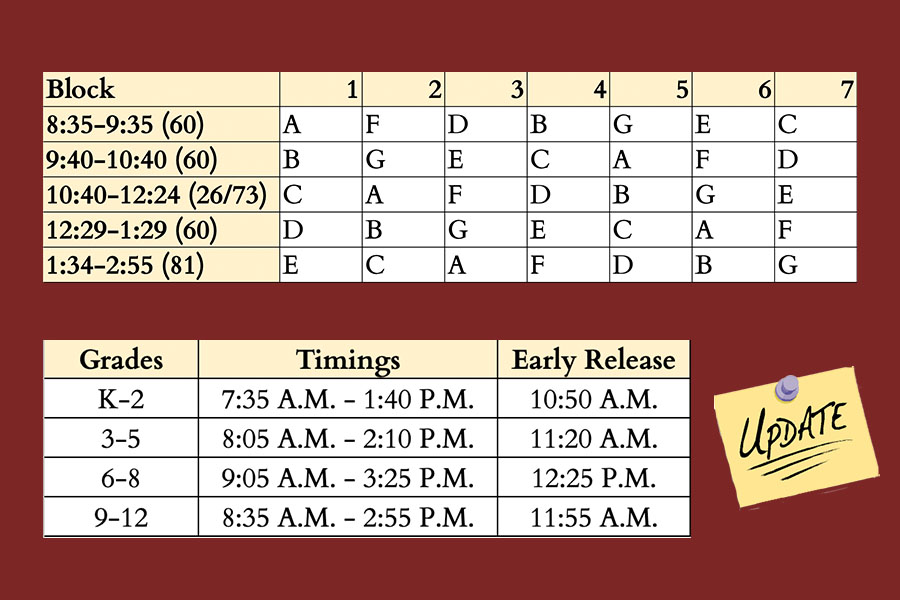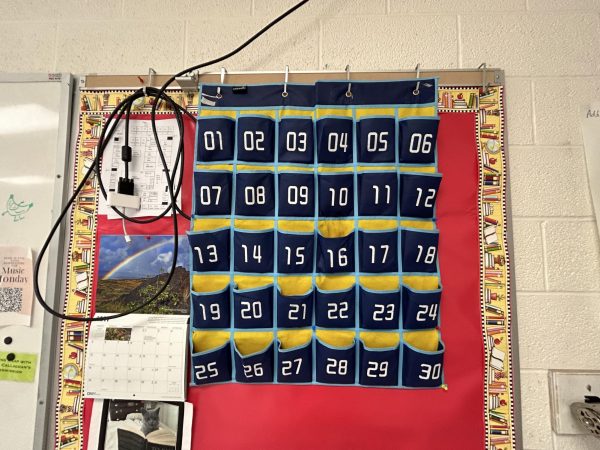Proposed start times and new WA schedule introduced for fall 2021
The new schedule and proposed start times for the 2021-2022 school year.
February 24, 2021
New timings based on parental feedback have been proposed for the 4-tier bus system meant to alleviate budget constraints, according to WA principal James Antonelli. Additionally, a pilot schedule for Westford Academy has been devised to serve as an effective transition back into school for the next year.
The next fiscal year faces a deficit of $990,000, as mentioned in the January 11 school committee meeting. By transitioning from a three-tier transportation system of thirty-six buses to a four-tier system of thirty-four buses, WPS will save $440,640.
According to Antonelli, the new proposal intends for K-2 to start at 7:35 AM and to end at 1:40 PM. Grades 3-5 will go from 8:05 AM to 2:10 PM. Westford Academy’s timings will be pushed back an hour; the school day will run from 8:35 AM to 2:55 PM. The middle school will run from 9:05 AM to 3:25 PM, having the latest start and end times.
These times have replaced the ones devised in January, as the new timings keep grades K-2 and 3-5 adjacent to one another. This will address the common concern of many parents who have children at both school levels, and make it more convenient for them to drop off and pick up their kids. The proposed start times will be voted on at the school committee meeting on March 8.
Along with the later start time, the WA schedule for the 2021-22 school year will have sixty-minute blocks instead of the previous fifty-minute ones, along with a long block that will be ninety-nine minutes long, including lunch. The last block at the end of the day is eighty-one minutes. This schedule, devised by Antonelli and other members of the administration, is meant to serve as a transition back to school from this year, which consists of only three classes per day.

“We have to look at things through a different lens moving forward. We now have remote learning, and [students] have been dealing with three classes a day. Imagine going back to six classes right now [for the next school year], I think all of your heads would spin-off,” Antonelli said.
In order to effectively schedule five blocks into the day, the last twenty minutes of the school day will be used flexibly; the time will be used for finishing tests, labs, or presentations in certain classes, as well as for meditation and relaxation. Although all eighty-one minutes will be structured learning time, athletes who have to attend away games will be dismissed early, sixty minutes into the block, to reach their games on time.
“[When a student gets dismissed for athletics, they] might be responsible for the work that they missed. But I do want to make sure that when there are dismissals, those students aren’t penalized for that. So, I’m still looking for that last block to be a solid sixty minutes [of learning] like every other block that we have, but there will be flexibility in the last twenty minutes,” Antonelli said.
Antonelli mentions that administration was considering having two seventy-minute blocks instead of the prolonged block at the end, but they decided against it, as they didn’t want the new schedule to mimic blocked scheduling, which isn’t ideal for high school students who have shorter attention spans.
Furthermore, the new schedule has five transition periods. Thus, students will have more instructional time than in previous years. WA has one of the shortest days in the county league, barely meeting the state requirement of having at least 990 instructional hours in each school year. That threshold will be more easily met with the new schedule.
However, this schedule is meant to be experimental. Antonelli plans to gain input from students and faculty about the structuring two or so months into the new school year, and then decide whether or not to move forward with it for the rest of the year.
Although several students support the schedule change, many are against the later start time for WA, as clubs will effectively be pushed back to end at 4:00 PM, and the later timings may affect several sports. Junior Nikita Ang believes that the start time will only be a detriment to students, and ultimately won’t improve sleep schedules.
“The committee that planned it out had good intentions but [pushing] start times back […] does really nothing but push the time that we have doing homework to a later slot, and [it] will make us go to bed later […]. 5 classes a day is the best idea in this plan […] as this would [result in] more class time but an overall small decrease in daily workload,” Ang said.
However, although the 2:55 end time is bound to affect extracurricular activities and sports, freshman Brenton Halio thinks that the start times can have a positive impact on students as long as they prioritize and manage their time properly, and don’t stay awake longer and further negatively impact their health.
“Whether these changes [will] result positively or negatively completely depends on whether or not [we are responsible]. If people [use the later start time] as an excuse to go to bed even later, the whole ‘Westford Moms’ talk of student health and sleep deprivation will just repeat itself […]. On the other hand, if people use it as an opportunity to get sufficient sleep before school, I believe it could be beneficial in many forms,” Halio said.
Antonelli accentuates Halio’s point of view, that students must try their best to sleep at at least the same time they would normally go to bed. He says that otherwise, the later start time will be a “moot point”.
“Don’t lose that hour, make [the timings] something that’s good for you […]. You guys need eight hours of sleep. And [many of you] are not getting it, but you need it,” Antonelli said.
He recognizes the impact of the shift on students and faculty, especially the disruption some staff will face regarding their commute, as they will face significantly more traffic after school. However, Antonelli says that if these timings aren’t adopted across the district, both faculty and program cuts will have to be made, which will hold a detrimental effect on electives and clubs, as well as on teachers and other staff members.
“We potentially could lose some faculty [members] based on the timings […]. But if we don’t do this, how do we get the $440,000? We’re going to lose faculty either way, because [if we don’t adapt to a four-tier system], Westford Academy is going to have to make some cuts,” Antonelli said.





















